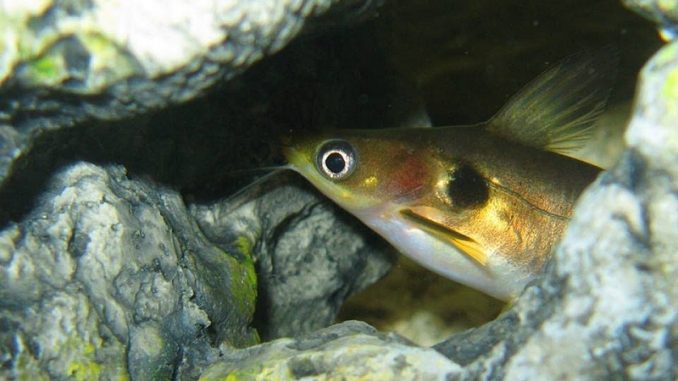
The Eclipse Catfish is a difficult-to-find species. It’s a nocturnal fish that is fun to watch, but if you’re thinking about adding one to an established aquarium, you’ll have to be mindful, as they will eat any fish that is smaller than they are.
In this article, I’ll discuss everything you need to know about raising Eclipse Catfish. I’ll discuss their background, diet, health concerns, and ideal habitat and water parameters.
TABLE OF CONTENTS
Eclipse Catfish Facts & Overview

| Category | Rating |
| Care Level: | Easy |
| Temperament: | Predatory with smaller fish |
| Color Form: | Yellowish-brown |
| Lifespan: | Up to 10 years |
| Size: | 12-18 inches |
| Diet: | Omnivore |
| Family: | Bagridae |
| Minimum Tank Size: | 75 gallons |
| Tank Set-Up: | Freshwater with caves, wood, and rocks |
| Compatibility: | Fish of the same size or larger |
Eclipse Catfish, scientific name Horabagrus Brachysoma, is native to Southwestern India, where they are found in the state of Kerala. They live in lakes, rivers, swamps, and pools, where they enjoy muddy and sandy habitats with thick plants and slow-moving currents.
In the wild, they feast on fish, insects, and muscles. As adults, they are large enough to eat insects from the ground and even frogs! Your home aquarium Eclipse Catfish won’t get big enough to eat a frog.
They have a number of other names, including:
- Asian Sun Catfish
- Burmese Sun Catfish
- Indian Sun Catfish
- Sun Catfish
- Sunspot Catfish
Typical Behavior
Eclipse Catfish are predatory fish and will swallow up any fish that are smaller than they are.
They are quiet during the day and like to hide among the rocks, caves, and wood. However, at night, they are much more active.
They do enjoy eating and don’t like to stop, so you’ll have to develop a sense of how much your Eclipse Catfish needs so that you’ll be able to control their food intake. You don’t want to underfeed them, but you don’t want to overfeed them, either.
Appearance
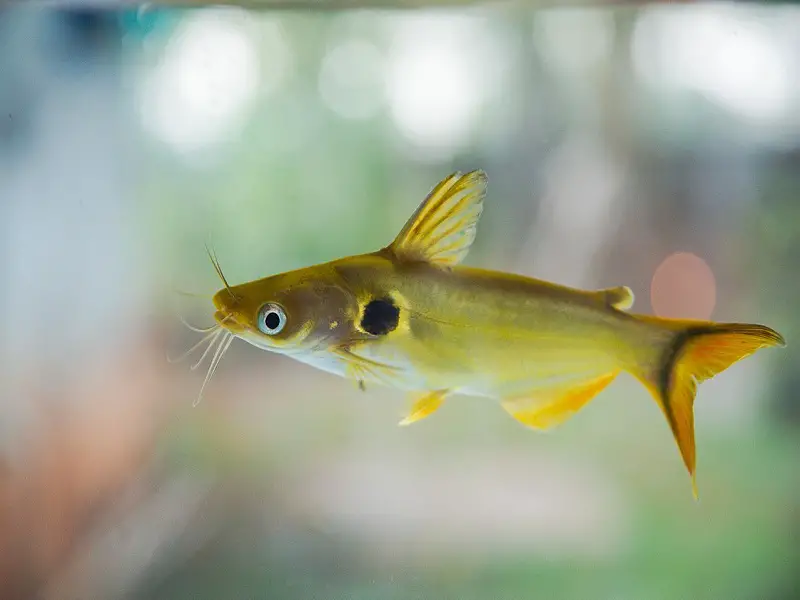
Eclipse Catfish are yellowish-brown in color and have a black mark across the top of their bodies that confirms their identity.
They also have four pairs of barbs, a caudal fin that is forked and a dorsal fin that is rounded. Their heads and eyes are large.
There are only two types of fish in the Horabagrus species, the Horabagrus Brachysoma, the Eclipse Catfish, and the Horobagrus Nigricollaris. The Eclipse Catfish is recognizable because it is larger.
In pictures, the Eclipse Catfish looks much smaller than it actually is. In the wild, it grows to 18 inches (45 cm). Although it will only get to 12 inches (30.5 cm), it is still pretty big for an aquarium fish.
Distinguishing between males and females
Although differentiating between females and males is extremely difficult, particularly since they won’t reach sexual maturity in captivity, you might be able to tell them apart by the male’s reddish vents. The female’s stomach is also soft and distended; however, you might not see that before she reaches maturity.
Habitat and Tank Conditions
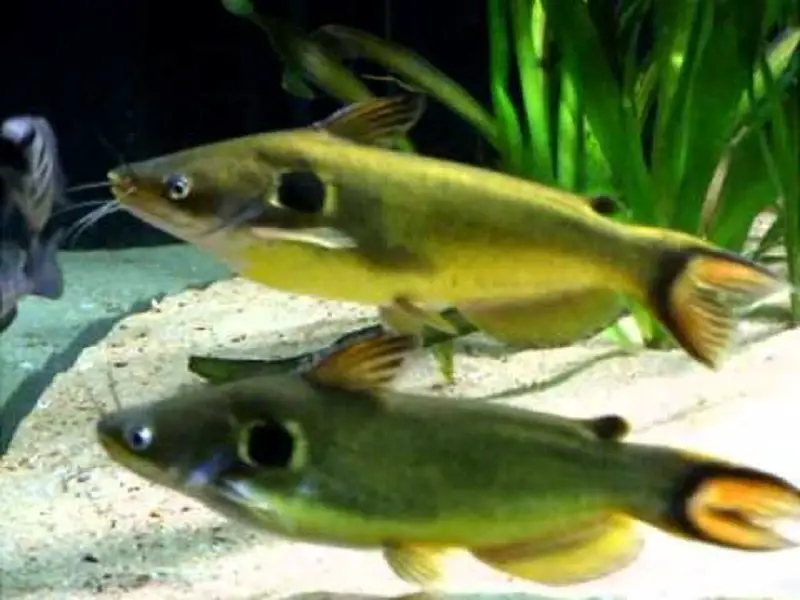
Eclipse Catfish are nocturnal creatures, so make sure to provide dim lighting; they don’t do well with bright light.
You should also provide lots of hiding places for them–they like caves, rocks, and wood. You can choose beech branches or large chunks of bogwood.
You’ll for sure need a filter since they produce so much waste. However, they are accustomed to slow-moving currents in their natural habitat, so you want to make sure that the filter does not increase the water flow too much. You could also put a plant in front of the filter uptake to disperse the water flow.
The substrate is also a consideration, and again, you’ll want to mimic their natural habitat as much as possible. In addition to rivers, these fish live in swamps and pools, so they are used to sandy and muddy bottoms.
Water Conditions
Eclipse Catfish are pretty adaptable to a variety of conditions. However, you want to stay within the parameters, as well as making sure to maintain the conditions you have, as sudden changes can negatively affect your fish.
Check levels frequently, particularly for ammonia, nitrate, and nitrite, since these levels have a tendency to rise with a large amount of waste that Eclipse Catfish produce. You may want to consider adding some cleaner fish or snails to help with the waste.
Even so, you should perform a 25% water change every other week. In terms of water hardness, Eclipse Catfish do well in soft to moderate water.
The optimal parameters to ensure the best quality of life for Eclipse Catfish:
- pH levels: 6-7.5
- Water hardness: 5-25dGH
- Water temperature: 74° to 77°F (23° to 25° C)
What Size Aquarium Do They Need?
You could keep one Sun Catfish in a 75-gallon (283.9-liter) tank, although if you can go bigger, that would be better.
If you are housing multiples or other species, of course, you’ll need to go larger than that.
Tank Mates
Make sure to pair Eclipse Catfish with fish that are about the same size. I promise that they will eat anything smaller than they are. Larger fish are acceptable tankmates, too, but then you’d be looking at a pretty large tank.
They would do ok with other catfish, although you might run into territorial spats.
Ideal tank mates include:
- Arowanas
- Cyprinids
- Large Characins
- Large Cichlids
Keeping Eclipse Catfish Together
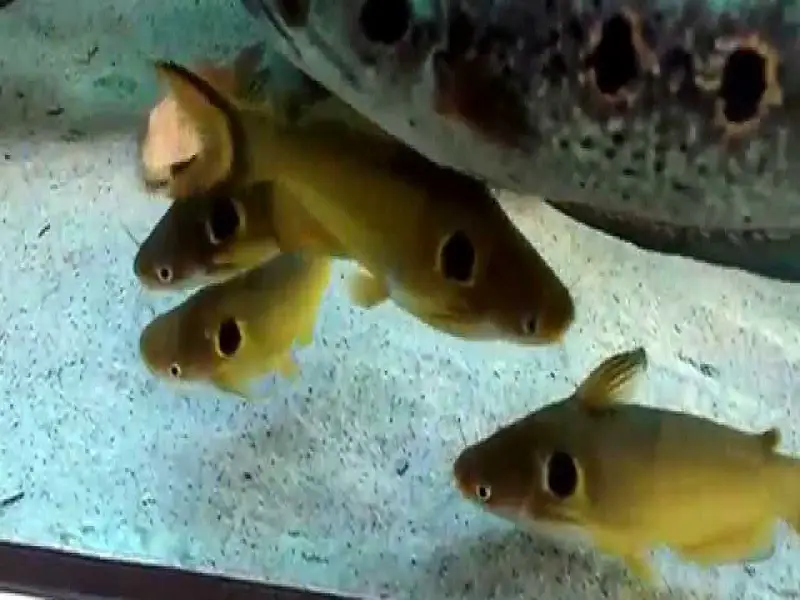
Designed to run with a group of about 6, Eclipse Catfish do better when they are together. That being said, they are more community-oriented when they are younger, and more solitary when they are adults.
Like other catfish, Eclipse Catfish are somewhat aggressive with others of their species. It’s the males that may fight, but their skirmishes shouldn’t draw blood and they won’t kill each other.
Diet
Eclipse Catfish are omnivores, so they will need a mix of protein and plant matter. They are also predators, so they’ll prefer the meaty protein; therefore, you’ll have to sneak the green goodness into their diets.
Although live food will be their first choice, they’ll also accept frozen and freeze-dried fish.
Good sources of protein include:
- Earthworms
- Insects
- Invertebrates
- Mussels
- Shrimp
- Small fish (yes, if you put them in an aquarium with smaller fish, Eclipse Catfish will eat them.)
Other food:
- Dried pellets
- Plant matter
You should feed your Eclipse Catfish a couple of times a day, but make sure to feed them only what they can consume in a few minutes. These fish create an enormous amount of waste, so it will be hard enough to keep their tank clean without adding to the job.
Care
Sadly, Eclipse Catfish are a vulnerable species due to the fact that they are often exploited and their natural habitat is polluted. If you are fortunate enough to come into possession of an Eclipse Catfish, you should do everything you can to provide the best care for and protect this fish.
If the conditions in their natural habitat don’t change, they will soon be endangered.
Watch for signs of disease and illness, such as bulging or cloudy eyes, white spots, inflammation, open sores, and lethargy.
If your Eclipse Catfish has any of these symptoms, they may have a parasitic disease such as ich or Skin Flukes, or bacterial or viral infection. They must be quarantined and treated immediately.
The other thing you can do is make sure they have as large a tank as you can accommodate. One of the reasons they grow much larger in the wild is that they have a lot more room. The more room they have, the less stressed they’ll be, and the more likely they’ll thrive.
Breeding
Although there have been reports of professionals successfully breeding Eclipse Catfish in captivity, there are no reported successes in a home aquarium. I do not recommend that you try.
We have suggested a 75-gallon minimum tank for one Eclipse Catfish, as these fish don’t grow nearly as large in captivity. These fish grow to a maximum of about 12 inches in captivity (30.5 cm), which is too small for them to reach sexual maturity.
In order to possibly ready them sexually for reproduction, you’d need a tank of at least 200 gallons in order for them to have enough space to grow large enough. Even on the off chance that you did have a tank large enough, that’s no guarantee that the Eclipse Catfish would reach that size.
In the wild, Eclipse Catfish are egg layers, with the males fertilizing the eggs after the females lay them.
Are Eclipse Catfish Suitable for your Aquarium?
Straight from the slow-moving backwaters and tributaries of Southwestern India to your home aquarium, Eclipse Catfish won’t do much during the day, but at night they are the life of the party, and you’ll enjoy watching them go after the live food you provide them.
As long as you have room for a larger tank and are not housing other catfish or smaller fish, Eclipse Catfish might be the right fish for you.
Do you keep Eclipse Catfish as singles or as a school? We’d love to know your experiences with these fish, so please share in the comments below.

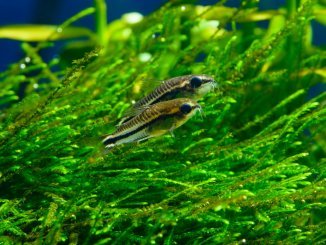
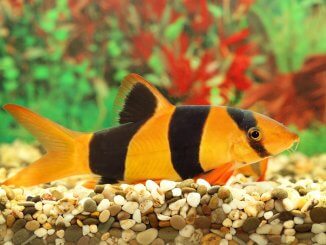
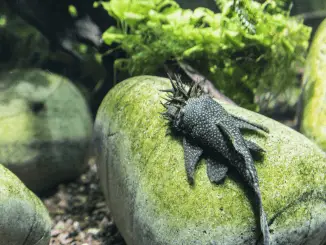
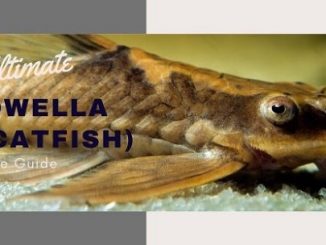
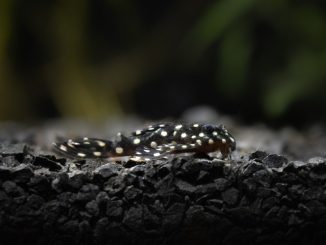
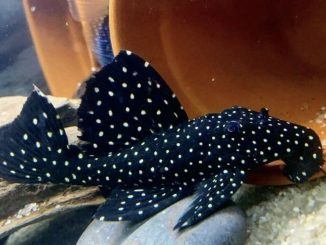
Can an eclipse catfish stay in an outside pond year round?